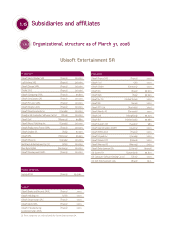Ubisoft 2005 Annual Report Download - page 51
Download and view the complete annual report
Please find page 51 of the 2005 Ubisoft annual report below. You can navigate through the pages in the report by either clicking on the pages listed below, or by using the keyword search tool below to find specific information within the annual report.
1
49
UBISOFT • 2006 ANNUAL REPORT
FINANCIER
The group’s activities and performance for fy 2005-06
or wholesalers, mainly in France and United Kingdom.
Most sales are made to so-called “major accounts”. The
risk of non-payment by these clients is relatively low.
Moreover, the main subsidiaries, which represent more
than 92% of Group sales, are covered by credit insurance.
Ubisoft’s 10 largest customers account for 40% of the
Group’s pre-tax sales.
Risk related to
dependence on suppliers
and subcontractors
The company has no significant financial dependence on
suppliers or subcontractors that could affect its develop-
ment plan.
Ubisoft and its subsidiaries primarily use the services and
products of such suppliers as integrators (e.g., printers
who produce the manuals and package the products, CD-
ROM and DVD-ROM suppliers who provide these media
and subcontract their duplication, and assemblers) as well
as firms that supply technology and provide licensing or
maintenance services within the relevant business context.
In addition, even though 75% of the company’s sales are
generated by games developed in-house, the company also
regularly uses the services of outside studios. The latter
can either provide traditional subcontracting services by
supplying additional and/or specialized production capa-
city, or assume responsibility for original projects in areas
where they have specialized skills. These independent stu-
dios sometimes have limited financial resources, which
may jeopardize the timely completion of a project. For this
reason, the company limits the number of games entrusted
to a single studio and arranges to acquire all or part of the
technology they use.
The company is, however, dependent on manufacturers to
some extent. Like all publishers of console games, Ubisoft
purchases game cartridges and media from console manu-
facturers. Procurement is therefore dependent on produc-
tion of the media. For PC games, there is no specific
dependence.
Market risk
The group limits its market involvement to the manage-
ment of positions resulting from its commercial activities
and does not engage in any speculative transactions. Risk
management is centralized and handled exclusively by the
staff of the group’s Finance department on the basis of gui-
delines approved by the CEO.
To limit interest rate and foreign exchange risk resulting
from business financing needs and international activities,
the group uses certain financial instruments, as described
below.
Interest rate risk:
The management of interest rate risk is aimed mainly at
minimizing the cost of the group’s borrowings and at redu-
cing exposure to this risk. In this regard, the group gives
priority to fixed-rate loans for long-term financing needs
and variable-rate loans to finance specific needs related to
an increase in working capital during particularly active
periods.
As of March 31, 2006, the group’s net debt consisted
mainly of bond debts and fixed-rate loans. The group is
therefore not greatly affected by a rise in interest rates but
is exposed to opportunity cost risk if rates decrease.
Since most of this debt is at a fixed rate, any fluctuation in
interest rates of ±1% would have an impact on operating
income equal to €288 thousand.
1.8.9
1.8.10
























